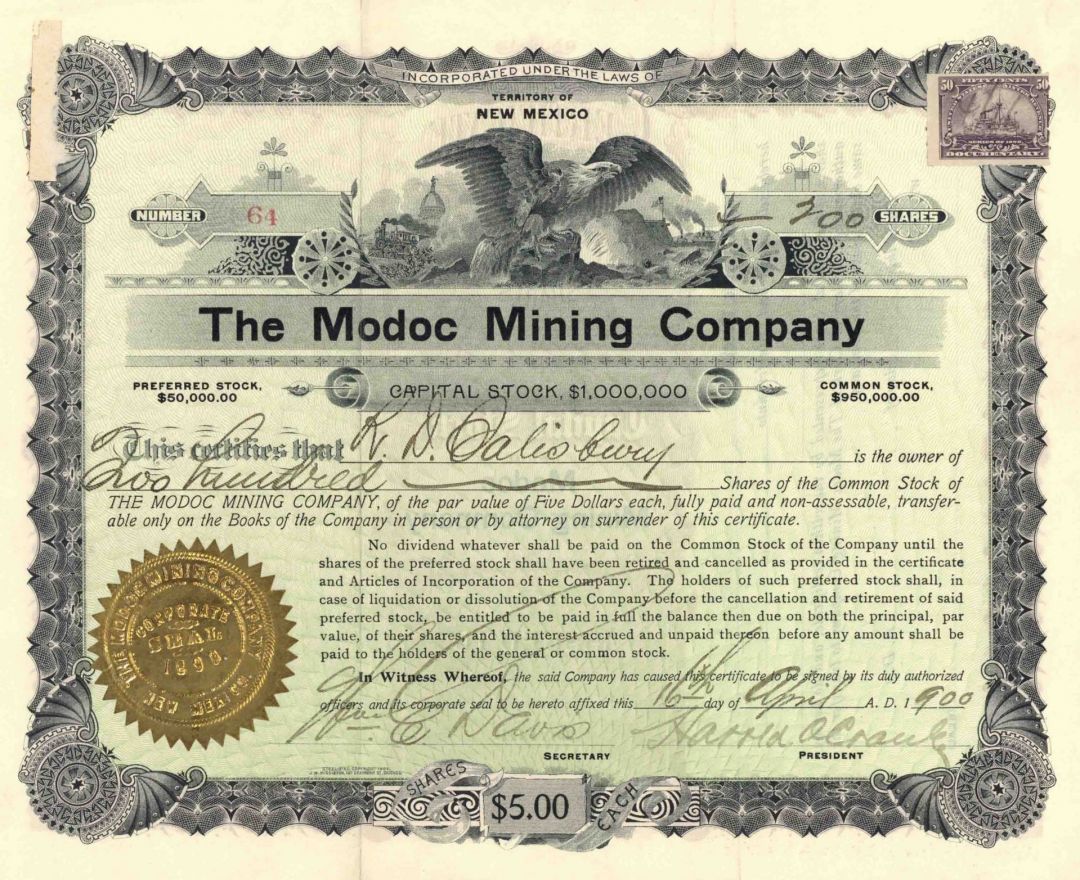Modoc Mining Co. - New Mexico Mining Stock Certificate
Inv# MS3242 StockStock.
The Territory of New Mexico was an organized incorporated territory of the United States from September 9, 1850, until January 6, 1912. It was created from the U.S. provisional government of New Mexico, as a result of Nuevo México becoming part of the American frontier after the Treaty of Guadalupe Hidalgo. It existed with varying boundaries until the territory was admitted to the Union as the U.S. state of New Mexico. This jurisdiction was an organized, incorporated territory of the US for nearly 62 years, the longest period of any territory in the contiguous United States.
New Mexico is a state in the Southwestern United States. It is one of the Mountain States of the southern Rocky Mountains, sharing the Four Corners region of the western U.S. with Utah, Colorado, and Arizona, and bordering Texas to the east and southeast, Oklahoma to the northeast, and the Mexican states of Chihuahua and Sonora to the south. The state capital is Santa Fe, which is the oldest capital in the U.S., founded in 1610 as the government seat of Nuevo México in New Spain; the largest city is Albuquerque.
New Mexico is the fifth-largest of the fifty states, but with just over 2.1 million residents, ranks 36th in population and 46th in population density. Its climate and geography are highly varied, ranging from forested mountains to sparse deserts; the northern and eastern regions exhibit a colder alpine climate, while the west and south are warmer and more arid; the Rio Grande and its fertile valley runs from north-to-south, creating a riparian climate through the center of the state that supports a bosque habitat and distinct Albuquerque Basin climate. One–third of New Mexico's land is federally owned, and the state hosts many protected wilderness areas and national monuments, including three UNESCO World Heritage Sites.
New Mexico's economy is highly diversified, with major sectors including oil drilling, mineral extraction, dryland farming, cattle ranching, acequia and landrace agriculture, lumber, retail, scientific research laboratories, technological development, and the arts, especially textiles and visual arts. Its total gross domestic product (GDP) in 2020 was $95.73 billion, with a GDP per capita of roughly $46,300. State tax policy is characterized by low to moderate taxation of resident personal income by national standards, with tax credits, exemptions, and special considerations for military personnel and favorable industries; subsequently, its film industry is one of the largest and fastest growing in the country. Due to its large area and economic climate, New Mexico has a significant U.S. military presence, most notably the White Sands Missile Range, and many U.S. national security agencies base their research and testing arms in the state, such as the Sandia and Los Alamos National Laboratories, known as Project Y during the 1940s; here, the Manhattan Project was responsible for the world's first atomic bomb and first nuclear test, Trinity.
In prehistoric times, New Mexico was home to Ancestral Puebloans, Mogollon, and the modern Comanche and Utes. Spanish explorers and settlers arrived in the 16th century, naming the territory Nuevo México after the Aztec Valley of Mexico, more than 250 years before the establishment and naming of the present-day country of Mexico; thus, the state did not derive its name from Mexico. Isolated by its rugged terrain and the relative dominance of its indigenous people, New Mexico was a peripheral part of the viceroyalty of New Spain. Following Mexican independence in 1821, it became an autonomous region of Mexico, though this autonomy was increasingly threatened by the centralizing policies of the Mexican government, culminating in the Revolt of 1837; at the same time, the region became more economically dependent on the United States. At the conclusion of the Mexican–American War in 1848, the U.S. annexed New Mexico as part of the larger New Mexico Territory. It played a central role in American westward expansion, and was admitted to the Union in 1912.
New Mexico's history has contributed to its unique demographic and cultural character. One of only six majority-minority states, it has the nation's highest percentage of Hispanic and Latino Americans and the second-highest percentage of Native Americans after Alaska. New Mexico is home to part of the Navajo Nation, 19 federally recognized Pueblo communities, and three different federally recognized Apache tribes. Its large Hispanic population includes Hispanos, who descend from early Spanish settlers, as well as Chicanos and Mexicans. The New Mexican flag, which is among the most recognizable in the U.S., reflects the state's eclectic origins, bearing the scarlet and gold coloration of Spain's Cross of Burgundy along with the ancient sun symbol of the Zia, a Puebloan tribe. The confluence of indigenous, Spanish, Mexican, Hispanic, and American influences is also evident in New Mexico's unique cuisine, music genre, and architecture.
A stock certificate is issued by businesses, usually companies. A stock is part of the permanent finance of a business. Normally, they are never repaid, and the investor can recover his/her money only by selling to another investor. Most stocks, or also called shares, earn dividends, at the business's discretion, depending on how well it has traded. A stockholder or shareholder is a part-owner of the business that issued the stock certificates.











Ebay ID: labarre_galleries